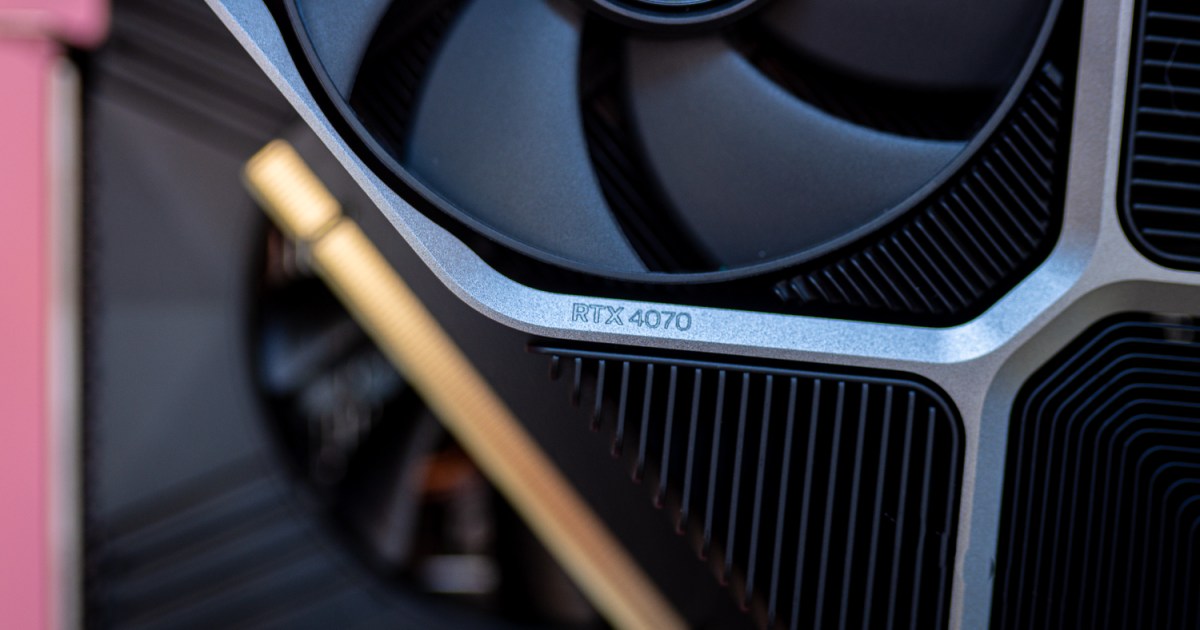Nvidia’s RTX 4070 is one of the best graphics cards you can buy, make no mistake about that. Some recent price drops, combined with excellent 1440p performance and features like DLSS 3.5, make it the go-to GPU for a high-end gaming experience in 2024. There are several other GPUs to keep in mind around this price, however.
The market around for graphics cards that cost $500 to $600 is hotly contested among AMD and Nvidia, and there are some other excellent options to keep in mind when shopping for a new GPU. Here are five GPUs to consider if you’re in the market for the RTX 4070.
Nvidia RTX 4070 Super
The most obvious replacement for the RTX 4070 is the RTX 4070 Super. This is a juiced-up version of the RTX 4070 that comes with a 20% bump in core count. It’s a huge leap in performance over the base RTX 4070, which is great considering the Super model comes in at only $50 more ($600 at list price).
Get your weekly teardown of the tech behind PC gaming
Although there’s a 20% bump in core count, there isn’t a 20% bump in performance. Overall, we found that this GPU is around 10% faster than the base model in our RTX 4070 Super review. There are some titles where it’s much faster, such as Returnal, where we saw a 20% jump. In other games, such as Cyberpunk 2077, the Super model barely moves the needle.
The important reason to consider the RTX 4070 Super is that it’s powerful enough to push the card over the 60 frames per second (fps) line at 4K. The base RTX 4070 fell just short of that mark, while the RTX 4070 Super can often cross 60 fps at 4K without help from upscaling. For an extra $50, and with all of Nvidia’s bells and whistles in tow, it’s hard to argue with what the RTX 4070 Super offers.
AMD RX 7900 GRE
AMD’s RX 7900 GRE is a strange GPU, and I’d forgive you if this is the first you’re hearing about it. It released last year exclusively in China, and it took several months for AMD to release it in the U.S. As you can read in our comparison between the RTX 4070 and RX 7900 GRE, AMD’s GPU is around 12% faster at 4K and 16% faster at 1440p — and it comes in at the same price of $550.
That performance gap includes ray tracing, which is an area where AMD graphics cards typically compromise. That’s not the case here. Although the RX 7900 GRE is behind in demanding ray tracing games like Cyberpunk 2077, it’s actually a bit faster in lighter ray tracing workloads like Returnal and Resident Evil 4.
Outside of ray tracing, AMD’s GPU is much faster overall. In games like Resident Evil 4, Returnal, and Red Dead Redemption 2, the RTX 4070 just barely passes the 60 fps line at 4K, while the RX 7900 GRE often reaches above 70 fps in these titles. The RX 7900 GRE comes with a larger VRAM pool of 16GB as well, making it useful in VRAM-hungry games like The Last of Us Part One.
The main compromise here is that the RX 7900 GRE doesn’t support DLSS 3 like the RTX 4070. AMD has its own FSR 3 feature, and it’s great. However, the feature currently lacks broad support like DLSS 3, so you’ll have to wait a while before it becomes a mainstay in new games.
Nvidia RTX 4070 Ti
Normally, the RTX 4070 Ti would be out of the question if you were interested in the base RTX 4070. The Ti model comes in at $800 normally, so it’s in an entirely different class of GPU. However, the release of the RTX 4070 Ti Super has pushed the price of the base model down significantly, and you can find it for under $700.
The RTX 4070 Ti, which we wrote off as an awkward step between midrange and high-end in our original RTX 4070 Ti review, looks a lot more attractive at its newly discounted price. Overall, the RTX 4070 Ti is about 15% faster than the base RTX 4070, outclassing both that GPU and the newly minted Super variant.
The only caveat here is that you’ll need to act fast if you want an RTX 4070 Ti. Nvidia is replacing the base model with the new Super version, so once stock is gone at retailers, it’s gone for good. Thankfully, the new Super model has pushed prices down on the secondhand market, too, so sites like eBay are a good place to shop if you want to score a deal.
AMD RX 6950 XT
AMD’s last-gen RX 6950 XT comes in at the same price as the RTX 4070 at $550. It’s a monster GPU by last-gen standards, able to deliver 60 fps and often higher in demanding games at 4K. Due to it being a last-gen card, you can find the RX 6950 XT for much cheaper than its original launch price, placing it in direct competition with the RTX 4070.
Overall, the RX 6950 XT is around 15% faster than the RTX 4070 when looking at rasterized games. Unfortunately, you give up quite a bit in the ray tracing department. AMD’s previous generation of graphics cards struggled with ray tracing, and the RX 6950 XT is no exception. It’s about 10% slower when you bring ray tracing into the mix.
Still, if you’re mainly concerned with raw performance without ray tracing on, the RX 6950 XT is a great way to go. It’s available for around the same price as the RTX 4070, and if you shop the secondhand market, you can find one even cheaper.
Nvidia RTX 3080
The RTX 4070 and last-gen’s RTX 3080 are very close in their performance. You could look at any game and see the GPUs trade blows by 5% in either direction. Nvidia’s last-gen flagship is available on the secondhand market for a bargain right now, though. You can commonly find a GPU around $400 to $450, with some going for as low as $350.
You’re getting largely similar performance for a much cheaper price. The RTX 3080 comes with less VRAM at 10GB, and the ray tracing performance is a touch slower, but those are acceptable compromises considering how much cheaper the card is right now.
The main trade-off is DLSS 3. The RTX 3080 doesn’t have access to Nvidia’s Frame Generation or Ray Reconstruction features, which can make a big difference in premier titles like Cyberpunk 2077 and Alan Wake 2. Given the price of the RTX 3080 right now, however, you’re getting a lot of GPU for very little money.
Editors’ Recommendations

-%20CookUnity%20Prepared%20Meals.png)



.png)

